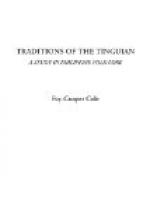When they reached the middle of the way they met the people of Kadalayapan, so they were a large party who went. When they arrived at Dagala, at the place where the spring is, they saw that all the stones by the river were gold and they were surprised, and the people who were dipping water from the spring were there. “You people who are dipping water, where is the shallow place for us to cross?” they said. “You look for the place where the people go across?” said the people who were dipping water. Not long after they went across the river. As soon as they reached the other side of the river, they took a bath. The women who were dipping water saw that the water which ran from their bodies were agates which had no holes. “How wonderful are the people who live in Kadalayapan and Kaodanan, for they are relatives of Kaboniyan [121] and they have power,” said the women who were dipping water from the well.
“You people who are dipping water, where is the trail which leads to the house of Algaba of Dagala?” they said. “Follow the head poles; they are along the road to his house,” said the women who were dipping water. So they went up truly to the town, and the boa constrictors which made the fence around the town did not move when they passed, for they were afraid, and when they arrived at the house of Algaba the alan danced. When they sat down Pagatipanan was in a hurry. “Ala! Langa-an, let us go and give the betel-nut which is covered with gold to Algaba,” he said and they went truly. They told Algaba that they were going to chew betel-nut, because they wished to learn if they were relatives; and Algaba said “That is good,” and they called Aponigawani to the house, and they cut the betel-nut in pieces. As soon as they cut it in pieces, “The best way to do is for you to tell your name first, because we came to visit you,” said Pagatipanan to Algaba. “No, old man, you tell your name first,” said Algaba. Not long after, “My name is Pagatipanan who am the Lakay [122] of Kadalayapan.” Not long after, “My name is Pagbokasan who is the father of Aponibalagen of Kaodanan.” Not long after, “My name is Algaba who is the son of an alan who has deformed feet, [123] who has no sister; we are not like you people who have power,” said Algaba. Not long after, “My name is Aponibalagen of Kaodanan who is the son of Ebang and Pagbokasan.” Not long after, “My name is Aponigawani of Kadalayapan who has no brother, so that when some enemies come into our town I dress in the bark of trees.” Not long after, “My name is Aponibolinayen who is the sister of Aponibalagen.” As soon as they told their names, they laid down their betel-nut quids. The quids of Algaba and Aponigawani both went to the quid of Pagatipanan, also the quids of Aponibalagen and Aponibolinayen went to the quid of Pagbokasan. Then Aponigawani stood up. “You are so strange, Algaba, you are my brother. I am so glad that I have a brother now. You are




